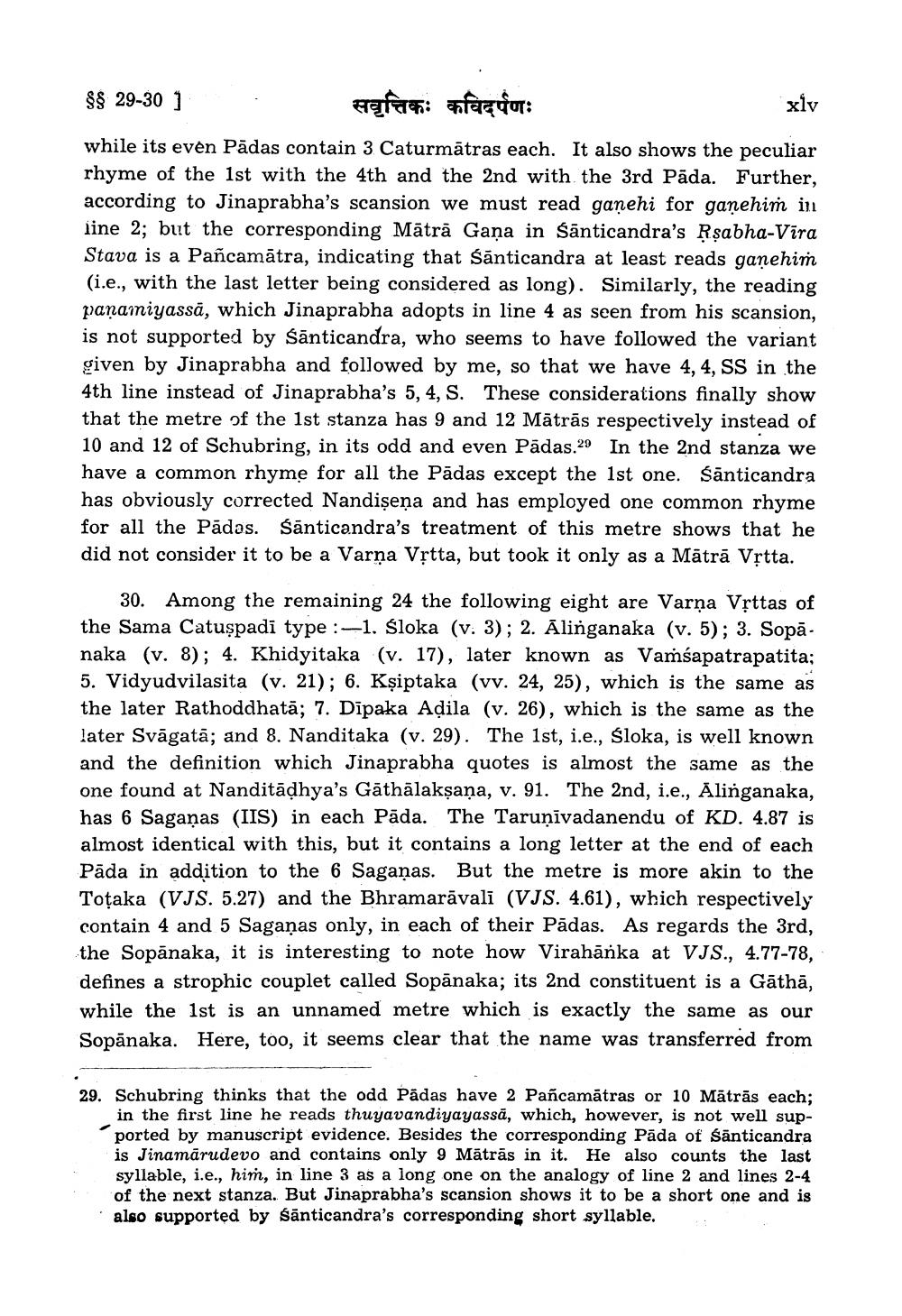________________
§§ 29-30 1
सवृत्तिकः कविदर्पणः
while its even Padas contain 3 Caturmätras each. It also shows the peculiar rhyme of the 1st with the 4th and the 2nd with the 3rd Päda. Further, according to Jinaprabha's scansion we must read ganehi for ganehim in iine 2; but the corresponding Mātrā Gaņa in Santicandra's Rṣabha-Vira Stava is a Pañcamātra, indicating that Santicandra at least reads ganehim (i.e., with the last letter being considered as long). Similarly, the reading paṇamiyassā, which Jinaprabha adopts in line 4 as seen from his scansion, is not supported by Santicandra, who seems to have followed the variant given by Jinaprabha and followed by me, so that we have 4, 4, SS in the 4th line instead of Jinaprabha's 5, 4, S. These considerations finally show that the metre of the 1st stanza has 9 and 12 Mātrās respectively instead of 10 and 12 of Schubring, in its odd and even Pādas.29 In the 2nd stanza we have a common rhyme for all the Pādas except the 1st one. Sānticandra has obviously corrected Nandişeņa and has employed one common rhyme for all the Pādas. Santicandra's treatment of this metre shows that he did not consider it to be a Varna Vṛtta, but took it only as a Mātrā Vṛtta.
xiv
30. Among the remaining 24 the following eight are Varna Vrttas of the Sama Catuşpadi type:-1. Sloka (v. 3); 2. Alinganaka (v. 5); 3. Sopā. naka (v. 8); 4. Khidyitaka (v. 17), later known as Vamsapatrapatita; 5. Vidyudvilasita (v. 21); 6. Kṣiptaka (vv. 24, 25), which is the same as the later Rathoddhatā; 7. Dipaka Aḍila (v. 26), which is the same as the later Svāgata; and 8. Nanditaka (v. 29). The 1st, i.e., Śloka, is well known and the definition which Jinaprabha quotes is almost the same as the one found at Nanditaḍhya's Gāthālakṣaṇa, v. 91. The 2nd, i.e., Alinganaka, has 6 Saganas (IIS) in each Pāda. The Taruņivadanendu of KD. 4.87 is almost identical with this, but it contains a long letter at the end of each Pāda in addition to the 6 Saganas. But the metre is more akin to the Toṭaka (VJS. 5.27) and the Bhramarāvali (VJS. 4.61), which respectively contain 4 and 5 Sagaņas only, in each of their Pādas. As regards the 3rd, the Sopānaka, it is interesting to note how Virahanka at VJS., 4.77-78, defines a strophic couplet called Sopānaka; its 2nd constituent is a Gāthā, while the 1st is an unnamed metre which is exactly the same as our Sopanaka. Here, too, it seems clear that the name was transferred from
29. Schubring thinks that the odd Pädas have 2 Pañcamātras or 10 Mātrās each; in the first line he reads thuyavandiyayassa, which, however, is not well supported by manuscript evidence. Besides the corresponding Pada of Santicandra is Jinamārudevo and contains only 9 Mātrās in it. He also counts the last syllable, i.e., him, in line 3 as a long one on the analogy of line 2 and lines 2-4 of the next stanza. But Jinaprabha's scansion shows it to be a short one and is also supported by Santicandra's corresponding short syllable.




